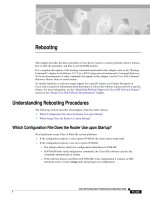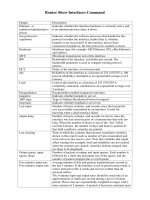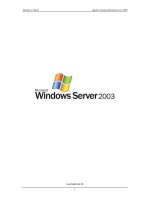Tài liệu mở rộng quản trị mạng IP Routing Route Selection in Cisco Routers
Bạn đang xem bản rút gọn của tài liệu. Xem và tải ngay bản đầy đủ của tài liệu tại đây (27.21 KB, 8 trang )
Cisco − Route Selection in Cisco Routers
Table of Contents
Route Selection in Cisco Routers.......................................................................................................................1
Introduction..............................................................................................................................................1
Processes Involved...................................................................................................................................1
Building the Routing Table......................................................................................................................1
Backup Routes............................................................................................................................2
Adjusting the Administrative Distance.......................................................................................2
Prefix Lengths.............................................................................................................................3
Making Forwarding Decisions.................................................................................................................3
IP Classless.................................................................................................................................4
Summary..................................................................................................................................................5
Tools Information....................................................................................................................................6
Related Information.................................................................................................................................6
Cisco − Route Selection in Cisco Routers
i
Route Selection in Cisco Routers
Introduction
Processes Involved
Building the Routing Table
Backup Routes
Adjusting the Administrative Distance
Prefix Lengths
Making Forwarding Decisions
IP Classless
Summary
Tools Information
Related Information
Introduction
One of the intriguing aspects of Cisco routers, especially for those new to routing, is how the router chooses
which route is the best among those presented by routing protocols, manual configuration, and various other
means. While route selection is much simpler than you might imagine, to understand it completely requires
some knowledge about the way Cisco routers work.
Processes Involved
There are three processes involved in building and maintaining the routing table in a Cisco router:
Various routing processes, which actually run a network (or routing) protocol, such as EIGRP, BGP,
IS−IS, and OSPF.
•
The routing table itself, which accepts information from the routing processes and also replies to
requests for information from the forwarding process.
•
The forwarding process, which requests information from the routing table to make a packet
forwarding decision.
•
Let's examine the interaction between the routing protocols and the routing table to understand how the
routing table is built.
Building the Routing Table
As each routing process receives updates and other information, it chooses the best path to any given
destination and attempts to install this path into the routing table. For instance, if EIGRP learns of a path
toward 10.1.1.0/24, and decides this particular path is the best EIGRP path to this destination, it tries to install
the path it has learned into the routing table.
The router decides whether or not to install the routes presented by the routing processes based on the
administrative distance of the route in question. If this path has the lowest administrative distance to this
destination (when compared to the other routes in the table), it's installed in the routing table. If this route isn't
Cisco − Route Selection in Cisco Routers
the route with the best administrative distance, then the route is rejected.
To understand this better, let's look at an example. Assume a router has four routing processes running:
EIGRP, OSPF, RIP, and IGRP. Now, all four of these processes have learned of various routes to the
192.168.24.0/24 network, and each has chosen its best path to that network through its internal metrics and
processes.
Each of these four processes attempts to install their route toward 192.168.24.0/24 into the routing table. The
routing processes are each assigned an administrative distance, which is used to decide which route to install.
Default Administrative Distances
Connected 0
Static 1
eBGP 20
EIGRP (internal) 90
IGRP 100
OSPF 110
IS−IS 115
RIP 120
EIGRP (external) 170
iBGP 200
EIGRP summary route 5
Since the internal EIGRP route has the best administrative distance, it's installed in the routing table.
Backup Routes
What do the other protocols, RIP, IGRP, and OSPF, do with the routes that weren't installed? What if the most
preferred route, learned from EIGRP, fails? Cisco IOS
®
Software uses two approaches to solve this problem:
The first is to have each routing process attempt to install its best routes periodically. If the most preferred
route fails, the next best route (according to administrative distance) succeeds on the next attempt. The other
solution is for the routing protocol that failed to install its route in the table to hang on to the route, and tell the
routing table process to report if the best path fails.
For protocols that don't have their own routing information tables, such as IGRP, the first method is used.
Every time IGRP receives an update about a route, it attempts to install the updated information in the routing
table. If there's already a route to this same destination in the routing table, the installation attempt fails.
For protocols that have their own database of routing information, such as EIGRP, IS−IS, OSPF, BGP, and
RIP, a backup route is registered when the initial attempt to install the route fails. If the route installed in the
routing table fails for some reason, the routing tabel maintenance process calls each routing protocol process
that has registered a backup route, and asks them to reinstall the route in the routing table. If there are multiple
protocols with registered backup routes, the preferred route is chosen based on administrative distance.
Adjusting the Administrative Distance
The default administrative distance might not always be right for your network; you may want to adjust them
so RIP routes are preferred over IGRP routes, for instance. Before explaining how to adjust the administrative
distances, we need to look at the implications of changing the administrative distance.
Cisco − Route Selection in Cisco Routers
Changing the administrative distance on routing protocols can be very dangerous! Changing the default
distances can actually lead to routing loops and other oddities in your network. We recommend you change
administrative distance with caution, and only after you have thought through what you want to achieve, and
all the consequences of your actions.
For entire protocols, changing the distance is relatively easy; simply configure the distance using the distance
command in the routing process subconfiguration mode. You can also change the distance for routes learned
from one source only in some protocols, and you can change the distance on just some routes.
For static routes, you can change the distance of each route by entering a distance after the ip route command:
ip route <network> <subnet mask> <next hop> <distance>
You can't change the administrative distance for all the static routes at once.
Prefix Lengths
Let's look at another scenario to see how the router handles another common situation: varying prefix lengths.
Assume, again, that a router has four routing processes running on it, and each process has received these
routes:
EIGRP (internal): 192.168.32.0/26•
RIP: 192.168.32.0/24•
OSPF: 192.168.32.0/19•
Which of these routes will be installed in the routing table? Since EIGRP internal routes have the best
administrative distance, it's tempting to assume the first one will be installed. However, since each of these
routes has a different prefix length (subnet mask), they're considered different destinations, and they will all
be installed in the routing table.
Let's see how the forwarding engine uses the information from the routing table to make forwarding decisions.
Making Forwarding Decisions
Let's look at the three routes we just installed in the routing table, and see how they look on the router.
router#show ip route
....
D 192.168.32.0/26 [90/25789217] via 10.1.1.1
R 192.168.32.0/24 [120/4] via 10.1.1.2
O 192.168.32.0/19 [110/229840] via 10.1.1.3
....
If a packet arrives on a router interface destined for 192.168.32.1, which route would the router choose? It
depends on the prefix length, or the number of bits set in the subnet mask. Longer prefixes are always
preferred over shorter ones when forwarding a packet.
In this case, a packet destined to 192.168.32.1 is directed toward 10.1.1.1, because 192.126.32.1 falls within
the 192.168.32.0/26 network (192.168.32.0 through 192.168.32.63). It also falls within the other two routes
available, but the 192.162.32.0/26 has the longest prefix within the routing table (26 bits verses 24 or 19 bits).
Cisco − Route Selection in Cisco Routers









